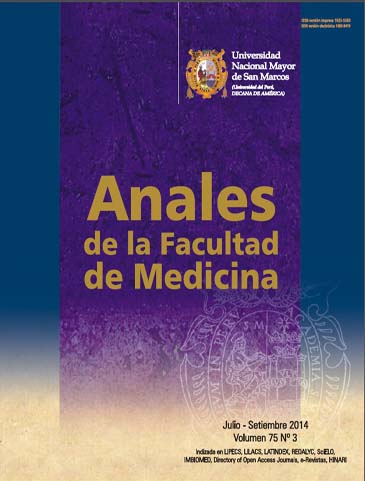High prevalence of toxocara positive serology in a Peruvian pediatric hospital
DOI:
https://doi.org/10.15381/anales.v75i3.9774Keywords:
Toxocara, serology, children.Abstract
Introduction: Zoonotic diseases transmitted by domestic animals may be considered a public health problem in developing countries. Objective: To determine the frequency of positive toxocara serology in clinically suspected children. Design: Descriptive, cross-sectional study. Setting: Instituto Nacional de Salud del Niño (INSN), Lima, Peru. Participants: Children with positive toxocara serology. Methods: Clinical records of children with suspicion of toxocara infection during the period 2007-2010 were included. Main outcome measures: Frequency and characteristics of toxocara seropositive cases. Results: From the 242 cases studied 61.2% (148) were toxocara seropositive, with average age 6.8 (SD 3.8) years; the group 2-10 years-old represented 69.6% of the total; eosinophilia was the main reason for consultation in 70.9%. Conclusions: High frequency of toxocara positive serology is found at INSN in suspicious patients, especially in children 2-10 years-old with eosinophilia.Downloads
Published
2014-09-15
Issue
Section
Trabajos originales
License
Copyright (c) 2014 Edwin Miranda Choque

This work is licensed under a Creative Commons Attribution-NonCommercial-ShareAlike 4.0 International License.
Those authors who have publications with this magazine accept the following terms:
- Authors will retain their copyrights and guarantee the journal the right of first publication of their work, which will be simultaneously subject to Creative Commons Attribution License that allows third parties to share the work as long as its author and its first publication this magazine are indicated.
- Authors may adopt other non-exclusive licensing agreements for the distribution of the version of the published work (eg, deposit it in an institutional electronic file or publish it in a monographic volume) provided that the initial publication in this magazine is indicated.
- Authors are allowed and recommended to disseminate their work over the Internet (eg: in institutional telematic archives or on their website) before and during the submission process, which It can produce interesting exchanges and increase quotes from the published work. (See El efecto del acceso abierto ).
How to Cite
1.
Miranda Choque E. High prevalence of toxocara positive serology in a Peruvian pediatric hospital. An Fac med [Internet]. 2014 Sep. 15 [cited 2024 Aug. 16];75(3):223-6. Available from: https://revistasinvestigacion.unmsm.edu.pe/index.php/anales/article/view/9774















